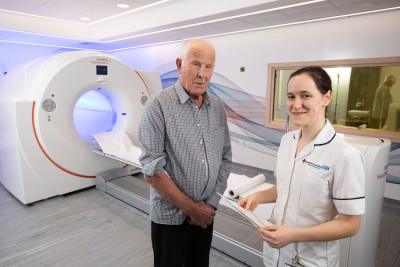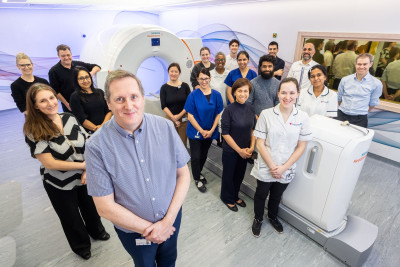
The £8 million positron emission tomography (PET) scanner, which has been newly installed at the Royal Free Hospital, is 11 times more sensitive than the latest standard machines.
It means patients are exposed to half as much radiation and can be scanned at least twice as quickly, allowing them to receive a diagnosis and start life-saving treatment sooner.
The new machine will also open up new opportunities for research, to improve our understanding of cancers and other diseases such as inflammatory conditions and the best way to treat them.
Michael O’Sullivan, 84, from High Barnet, had a scan this week as part of his prostate cancer care.
He said: “I was really pleased to be one the first patients and that my appointment went very smoothly. I felt very relaxed and the staff were all lovely and put me at ease.”
PET scans, which are carried out by the nuclear medicine team, create three-dimensional pictures of parts of the body. Patients are given a mildly radioactive solution, which is then absorbed by the part of the body that doctors wish to look at. This radioactive material lights up in the scan, allowing doctors to see how the patient’s tumour or part of the body is functioning.
For patients with cancer, understanding more about how a tumour functions means they can receive more effective treatments. A PET scan is used as part of a suite of diagnostic tools that help doctors determine the best treatment for each patient.
The new scanner, funded by the Royal Free Charity, is called a long axial field of view or LAFOV. It is also known as a Total Body PET scanner. Because it is much more sensitive than the trust’s current scanner, it allows clinicians to take an image in a much shorter length of time.
The machine also allows clinicians to view all the internal organs at once, rather than in sections as with previous scanners. This means they will gain a greater understanding of how organs function together, opening up new research opportunities.

Once the new equipment is up and running, it will speed up scanning time from 20 to five minutes, freeing up capacity to see more patients in a matter of days of referral, rather than weeks.
This is because the LAFOV PET scanner is more sensitive than other PET scanners and needs a much smaller dose of radiation to produce high-quality images. It means that healthy volunteers could be scanned as part of a research trial aimed at understanding more about how internal organs function.
Thomas Wagner, nuclear medicine consultant, said: “This is an extremely exciting development for us. The lower dose of radiation is a great benefit to patients, especially for younger patients who need to come for repeat scans. And because we can complete the scans much more quickly, we can see more patients every day and reduce waiting times for all patients needing a PET scan.”
Peter Landstrom, chief executive of the Royal Free London, said: “I’m delighted that the first patients are now receiving their scans. It will mean patients can be seen faster with less exposure to radiation.
“We have one of the largest cancer services in the country and the Total Body PET scanner will open up new avenues of research and allow us to develop ever more effective new treatments.
“Huge thanks should go to Royal Free Charity and its generous donors for making this possible.”
Jon Spiers, chief executive, Royal Free Charity, said: “The UK is grappling with one of the highest rates of late cancer diagnosis and the demand for cancer care in north London is projected to surge in coming years.
“Against this backdrop, our role as the Royal Free London’s NHS charity partner is more crucial than ever before. By securing funding that would otherwise not be available, we’re directly enabling an increase in cancer diagnostic capacity and speed.
“We’re extremely grateful to the Biss Davies Charitable Trust, Garfield Weston Foundation, Goldman Sachs Gives and the Kusuma Trust UK for their generous contributions to this project.
“Along with the support of countless individuals and community groups, we’re helping the trust to go further and faster than it could do with NHS funding alone.”
Top image: Patient Michael O'Sullivan with nuclear medicine technologist Ana Leite.
Bottom image: The nuclear medicine team with the new scanner.
 Translate
Translate